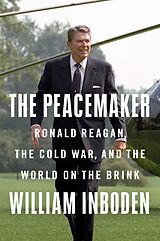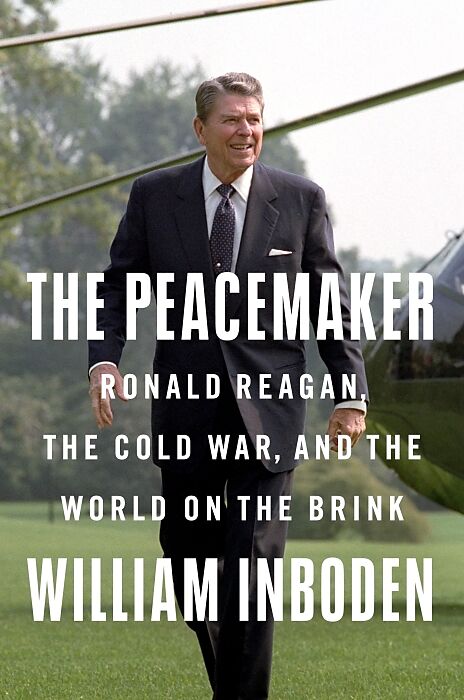The Peacemaker
Einband:
Fester Einband
EAN:
9781524745899
Untertitel:
Ronald Reagan, the Cold War, and the World on the Brink
Genre:
Politikwissenschaft
Autor:
William Inboden
Herausgeber:
Random House N.Y.
Anzahl Seiten:
608
Erscheinungsdatum:
15.11.2022
ISBN:
978-1-5247-4589-9
Informationen zum Autor William Inboden is executive director of the Clements Center for National Security and associate professor of Public Policy and History at the LBJ School of Public Affairs, both at the University of Texas at Austin. Prior to academia, he worked for fifteen years as a policymaker in Washington, DC, and overseas, including senior positions with the State Department and the National Security Council in the George W. Bush administration. A graduate of Stanford University, he earned his doctorate at Yale. He is a life member of the Council on Foreign Relations and his commentary has appeared in numerous outlets, including the Wall Street Journal , the New York Times , the Washington Post , the Los Angeles Times , Foreign Affairs , Foreign Policy , The Weekly Standard , World , NPR, CNN, Sky News, and the BBC. Klappentext "Today, the ending of the Cold War seems a foregone conclusion. But in the early 1980s, U.S. intelligence predicted the Soviet Union would last another century. Ronald Reagan entered the White House with no certainty of what would happen next, only an overriding faith in American democracy and an abiding belief that the communist system--and the threat of nuclear war--must be brought to an end. The Peacemaker is the story of the eight years of Reagan's presidency, as he and his foreign policy team managed, in real time, multiple crises around the globe."-- Leseprobe Chapter 1 East of California I On Tuesday, November 13, 1979, an eager audience gathered in the ballroom of the New York City Hilton to hear the worst-kept secret in politics revealed. Former governor of California Ronald Reagan was going to announce his third attempt at the presidency. His first campaign, in 1968, had been a half-hearted effort soon stymied by his California rival Richard Nixon. His second effort, in 1976, a primary challenge against the incumbent Gerald Ford, had come within a heartbreak of victory, ending only on a sweltering summer night in Kansas City at the Republican convention when Ford's delegate count barely beat Reagan's. It was the last time in American presidential politics when a political convention determined a major party's nominee. Many also expected it was the last time Reagan would seek the White House. But the ensuing years of the Jimmy Carter presidency also witnessed Reagan's new incarnation as a conservative speaker and broadcaster who stayed in the public eye-and kept his own eager eyes on the White House. Now aged sixty-eight, Reagan stood at once as a conservative icon and an old man. His campaign aimed to persuade Republican primary voters to focus on the former and disregard the latter. Perhaps seeking to recapture the enchantment of his political debut, 1964's "A Time for Choosing," the television speech that launched his political career, Reagan forsook the traditional campaign announcement before a hometown crowd and instead returned to a nationwide broadcast. His campaign purchased airtime on some eighty television stations across the nation to reintroduce viewers to the man who would be president. Arriving inside the Hilton from Gotham's chill fall air, the two thousand guests encountered the singular blend of Hollywood and Washington, DC, that would define the Reagan presidency. His good friend and fellow actor Jimmy Stewart welcomed the audience and introduced Reagan, who took the stage and began to speak to the gathered crowd-and to a curious nation. For the man who would devote much of his presidency to waging the Cold War, Ronald Reagan gave but a perfunctory mention to the Soviet Union. Instead, he spent most of his foreign policy attention on North America. Proclaiming, "We live on a continent whose three countries possess the assets to make it the strongest, most prosperous and self-sufficient area on earth," he called for "a develo...
Autorentext
William Inboden is executive director of the Clements Center for National Security and associate professor of Public Policy and History at the LBJ School of Public Affairs, both at the University of Texas at Austin. Prior to academia, he worked for fifteen years as a policymaker in Washington, DC, and overseas, including senior positions with the State Department and the National Security Council in the George W. Bush administration. A graduate of Stanford University, he earned his doctorate at Yale. He is a life member of the Council on Foreign Relations and his commentary has appeared in numerous outlets, including the Wall Street Journal, the New York Times, the Washington Post, the Los Angeles Times, Foreign Affairs, Foreign Policy, The Weekly Standard, World, NPR, CNN, Sky News, and the BBC.
Klappentext
Winner of the Society of Presidential Descendants Book Award and the Age of Reagan Conference Book Prize
One of the Wall Street Journal’s best political books of 2022
A masterful account of how Ronald Reagan and his national security team confronted the Soviets, reduced the nuclear threat, won the Cold War, and supported the spread of freedom around the world.
“Remarkable… a great read.”—Robert Gates • “Mesmerizing… hard to put down.”—Paul Kennedy • “Full of fresh information… will shape all future studies of the role the United States played in ending the Cold War.”—John Lewis Gaddis • “A major contribution to our understanding of the Reagan presidency and the twilight of the Cold War era.”—David Kennedy
With decades of hindsight, the peaceful end of the Cold War seems a foregone conclusion. But in the early 1980s, most experts believed the Soviet Union was strong, stable, and would last into the next century. Ronald Reagan entered the White House with no certainty of what would happen next, only an overriding faith in democracy and an abiding belief that Soviet communism—and the threat of nuclear war—must end.
The Peacemaker reveals how Reagan’s White House waged the Cold War while managing multiple crises around the globe. From the emergence of global terrorism, wars in the Middle East, the rise of Japan, and the awakening of China to proxy conflicts in Latin America, Africa, and Asia, Reagan’s team oversaw the worldwide expansion of democracy, globalization, free trade, and the information revolution. Yet no issue was greater than the Cold War standoff with the Soviet Union. As president, Reagan remade the four-decades-old policy of containment and challenged the Soviets in an arms race and ideological contest that pushed them toward economic and political collapse, all while extending an olive branch of diplomacy as he sought a peaceful end to the conflict.
Reagan’s revolving team included Secretaries of State Al Haig and George Shultz; Secretaries of Defense Caspar Weinberger and Frank Carlucci; National Security Advisors Bill Clark, John Poindexter, and Bud McFarlane; Chief of Staff James Baker; CIA Director Bill Casey; and United Nations Ambassador Jeane Kirkpatrick. Talented and devoted to their president, they were often at odds with one another as rivalries and backstabbing led to missteps and crises. But over the course of the presidency, Reagan and his team still developed the strategies that brought about the Cold War’s peaceful conclusion and remade the world.
Based on thousands of pages of newly-declassified documents and interviews with senior Reagan officials, The Peacemaker brims with fresh insights into one of America’s most consequential presidents. Along the way, it shows how the pivotal decade of the 1980s shaped the world today.
Zusammenfassung
One of the Wall Street Journal&rsquo…

Leider konnten wir für diesen Artikel keine Preise ermitteln ...
billigbuch.ch sucht jetzt für Sie die besten Angebote ...
Die aktuellen Verkaufspreise von 5 Onlineshops werden in Realtime abgefragt.
Sie können das gewünschte Produkt anschliessend direkt beim Anbieter Ihrer Wahl bestellen.
Loading...
Die aktuellen Verkaufspreise von 5 Onlineshops werden in Realtime abgefragt.
Sie können das gewünschte Produkt anschliessend direkt beim Anbieter Ihrer Wahl bestellen.
| # | Onlineshop | Preis CHF | Versand CHF | Total CHF | ||
|---|---|---|---|---|---|---|
| 1 | Seller | 0.00 | 0.00 | 0.00 |
